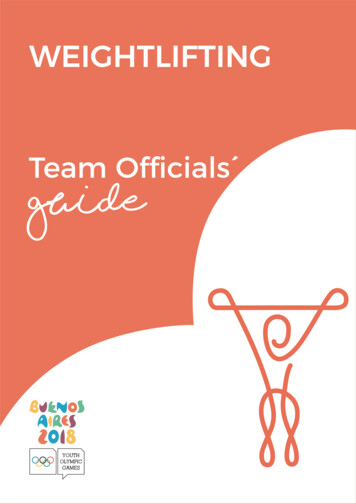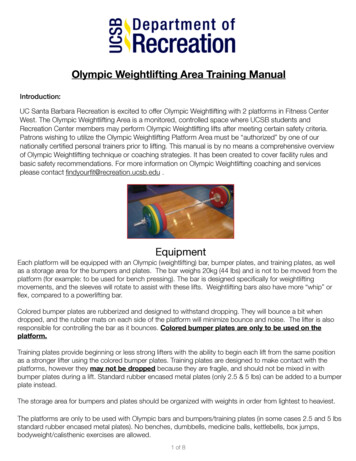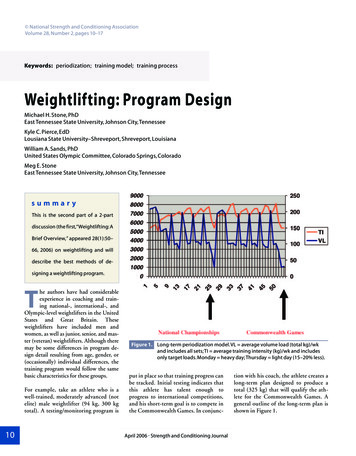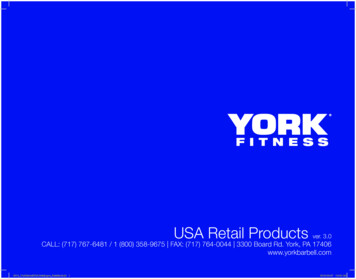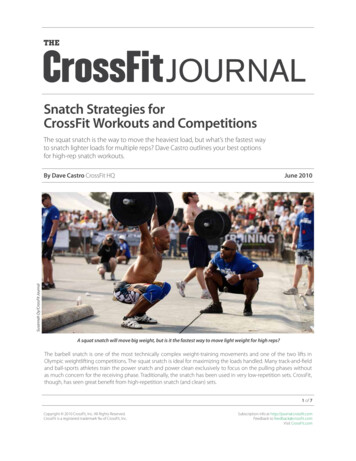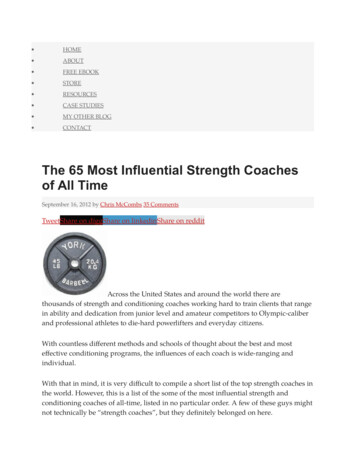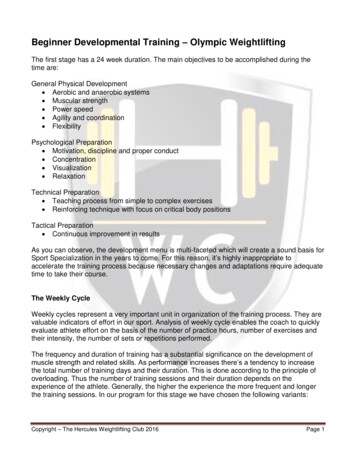
Transcription
Beginner Developmental Training – Olympic WeightliftingThe first stage has a 24 week duration. The main objectives to be accomplished during thetime are:General Physical Development Aerobic and anaerobic systems Muscular strength Power speed Agility and coordination FlexibilityPsychological Preparation Motivation, discipline and proper conduct Concentration Visualization RelaxationTechnical Preparation Teaching process from simple to complex exercises Reinforcing technique with focus on critical body positionsTactical Preparation Continuous improvement in resultsAs you can observe, the development menu is multi-faceted which will create a sound basis forSport Specialization in the years to come. For this reason, it’s highly inappropriate toaccelerate the training process because necessary changes and adaptations require adequatetime to take their course.The Weekly CycleWeekly cycles represent a very important unit in organization of the training process. They arevaluable indicators of effort in our sport. Analysis of weekly cycle enables the coach to quicklyevaluate athlete effort on the basis of the number of practice hours, number of exercises andtheir intensity, the number of sets or repetitions performed.The frequency and duration of training has a substantial significance on the development ofmuscle strength and related skills. As performance increases there’s a tendency to increasethe total number of training days and their duration. This is done according to the principle ofoverloading. Thus the number of training sessions and their duration depends on theexperience of the athlete. Generally, the higher the experience the more frequent and longerthe training sessions. In our program for this stage we have chosen the following variants:Copyright – The Hercules Weightlifting Club 2016Page 1
Three practice sessions per week during week 1 – 4DaysPracticeMon1.5 hourTueWed1.5 hourThuFri1.5 hourSatSunTotal4.5 hoursSatSunTotal6 hoursSat1.5 hourSunTotal7.5 hoursThree practice sessions per week during week 5-12DaysPracticeMon2 hoursTueWed2 hoursThuFri2 hoursFour practice sessions per week during week 13-24DaysPracticeMon2 hoursTueWed2 hoursThuFri2 hoursEvaluation of Teaching ProcessYoung weightlifters do not always approach mastery of lifting technique as priority. They oftenbelieve the important measurement is how much weight they can lift. For that reason,evaluation of technical preparation has to be incorporated into the program.During the 24 weeks of training I perform the evaluation on a quarterly basis and as follow:After 4 weeks of training: Power snatch – 90% Power clean & jerk – 90%After 8 weeks of training: Snatch – 90% Clean & jerk – 90%After 12 weeks of training: Snatch – 95% Clean & jerk – 95%After 16 weeks of training: Snatch – 95% Clean & jerk – 95% Back squats – 95%After 20 weeks of training: Snatch – 95% Clean & jerk – 95% Back squats – 95%And during weeks 23-24 Snatch – 100% Clean & jerk – 100% Back squats – 100%Copyright – The Hercules Weightlifting Club 2016Page 2
Training GuidelinesBefore each training session, the athlete should be engaged in a general body warm-up,consisting of exercises such as jogging, cycling, stepper, mobility exercises and stretching.Before each new exercise a specific warm-up should be performed. This type of warm-up willconsist of movements that are similar to that specific exercise. Once completed, resistance willbe gradually increased corresponding with the training session’s objectiveThe cool-down period after each training session should consist of low intensity exercises, corework and stretching.Loading code:50 45 load %# of sets# of repsThe amount of weight should be administered to the athlete on an individual basis, dependingon their ability level. At the start of the Beginner Developmental Program and until youestablish results for the Snatch and the Clean & Jerk think of the percentages as trainingzones. For this reason, we use the following system to determine the amount of weight lifted:50 % or60 % or70 % or80 % or90 % or100% orwarm-up weightlight weightmedium weightmedium-heavy weightheavy weightvery heavy weightWhen the results and the strength grow you need to revise the kilogram numbers, in mostcases the revision will happen every 6 – 12 weeks. Because everyone reacts to training load ina different way I personally don’t use any strict timelines. The art of coaching is to observe andanalyze. The main task is to guide the loading in order to train at the threshold of beingchallenged, not under trained and not over trained.Squat Weight SelectionSelection of weights for squats is rather tricky. We don’t advise to test front or back squatsduring the first several weeks of the Beginner Developmental Program. As a rule, we use %of clean & jerk as a foundation and then modify the numbers based on the individual lifter.At the beginning create a loading chart where you start with comfortable weights. Train for 2-3weeks and if the weights prove to be not challenging enough revise upward. The objective is tolift heavier and heavier but you only raise the numbers if the posture is correct and the effortdiminishes due to the strength development.Copyright – The Hercules Weightlifting Club 2016Page 3
Below is the loading chart example where based on the athlete evaluation you would useexpected clean & jerk performance numbers, then add 10% for the front squats and 20% forthe back squats to create the loading chart:Expected clean & jerkFront squat example 10%Back squat example 20%50%40 kg44 kg48 kg60%48 kg53 kg58 kg70%56 kg61 kg66 kg80%64 kg70 kg76 kg90%71 kg78 kg86 kg100%80 kg88 kg96 kgNotes:Exercises should be performed over a full range of motion using strict form at all times, withoutundue strain.Auxiliary exercises such as up-right rowing or deltoid flies should be performed with light tomedium weights. Their purpose is that of general development and not as main loadingexercises. I don’t add these repetitions to the overall program volume or intensity.The rest between exercises should be 3-4 minutes.The rest between sets in an exercise will vary depending on the number of repetitions,complexity of the exercise and the intensity. On average, this should be anywhere from 1-3minutes between sets per exercise.Proper breathing is also very important, and it should be stressed that extended breath holdingcan be very dangerous.There might be a need to slightly modify the program based on the individual circumstances. Itmust be kept in mind however, that such modifications would not result in a dramatic change ofthe program structure. Rather, a change in smaller variables such as shifting a workout or two,reducing or increasing sets or repetitions, would be target.When engaged in a regular training, an athlete should also pay special attention to adequaterest and nutrition.Copyright – The Hercules Weightlifting Club 2016Page 4
Exercise DescriptionsVertical jumps – squat down and jump up, hold straight back, swing arms in a “touch the floorand touch the ceiling” fashion, do not stop between repetitions.Snatch Squats – hold the barbell overhead with the snatch grip, squat down into the fullbottom positionLifts from the hang – start with the barbell at the hip level, lower weight to right above thekneesLifts below the knees – start with the barbell at the hip level, lower weight right down to theplatform without placing it on groundSnatch pulls full extension – it is a fast pulling motion without the jump, emphasis on hip andbody extension with a raise on toes at the end of the pullPulls with 4 stops – stop for 2 seconds in 4 positions on the way up: right above the platform,knee height, halfway up the thighs, and full extension at the hip level without bending the arms.On the way down, lower the weight slowly in one continuous motionSlow tempo – 3-5 seconds down and 3-5 seconds upHalf squat jumps – with the barbell behind the neck perform half squat, jump up, performcontinues jumping for the prescribed number of repetitionsBack squat with raise on toes – perform regular back squat with an addition of toes raise tofinish the standing up partRDL’s – hold the barbell at the waist level, unlock the knees, lower the weight by bending overat the hip joints, don’t use legs, bring the barbell back to the waist level90 % mini test – after proper warm-ups continue increasing weight till you reachapproximately 90 % of your current potential. Do not increase weight if the technique isincorrect.In most cases I ask the lifter to perform warm-up with the bar and then use regular progressingwith 50% two sets with 4 repetitions, 60% one or two sets with 3 repetitions, 70% one set with2 repetitions, 80% one set with 2 repetitions, 85% one or two set with 1 repetition, then 90%one set with 1 repetition.95 % mini test – as with 90 % but continue to increase weight till you reach 95 % of yourpotential. Stop progressing weight if you are failing with correct technique or dropping theweight.Copyright – The Hercules Weightlifting Club 2016Page 5
Before each training session, the athlete should be engaged in a general body warm-up, consisting of exercises such as jogging, cycling, stepper, mobility exercises and stretching. Before
